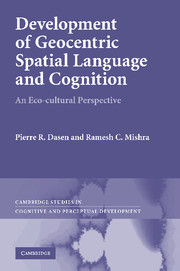Description
Development of Geocentric Spatial Language and Cognition
An Eco-cultural Perspective
Cambridge Studies in Cognitive and Perceptual Development Series
Authors: Dasen Pierre R., Mishra Ramesh C.
Investigates the acquisition and use of geocentric spatial language for children in Bali, India, Nepal, and Switzerland.
Language: English
Subject for Development of Geocentric Spatial Language and Cognition:
Approximative price 32.87 €
In Print (Delivery period: 14 days).
Add to cart
Development of Geocentric Spatial Language and Cognition
Publication date: 01-2013
Support: Print on demand
Publication date: 01-2013
Support: Print on demand
Approximative price 111.60 €
In Print (Delivery period: 14 days).
Add to cart
Development of geocentric spatial language and cognition: an eco-cultural perspective
Publication date: 08-2010
408 p. · 15.4x23.4 cm · Hardback
Publication date: 08-2010
408 p. · 15.4x23.4 cm · Hardback
Description
/li>Contents
/li>
Egocentric spatial language uses coordinates in relation to our body to talk about small-scale space ('put the knife on the right of the plate and the fork on the left'), while geocentric spatial language uses geographic coordinates ('put the knife to the east, and the fork to the west'). How do children learn to use geocentric language? And why do geocentric spatial references sound strange in English when they are standard practice in other languages? This book studies child development in Bali, India, Nepal, and Switzerland and explores how children learn to use a geocentric frame both when speaking and performing non-verbal cognitive tasks (such as remembering locations and directions). The authors examine how these skills develop with age, look at the socio-cultural contexts in which the learning takes place, and explore the ecological, cultural, social, and linguistic conditions that favor the use of a geocentric frame of reference.
Part I. Introduction and Methods: 1. Theory and research questions; 2. Methods; 3. Settings; Part II. Results: 4. Pilot study in Bali and first study (India and Nepal, 1999–2000); 5. Returning to Bali: main study 2002–7; 6. Varanasi; 7. Kathmandu; 8. Panditpur; 9. Geneva; Part III. Additional Studies: 10. Spatial language addressed to children; 11. Geocentric gestures before language?; 12. Spatial organization schemes; 13. Neurophysiological correlates of geocentric space; 14. Geocentric dead reckoning; Part IV. Conclusions: 15. Discussion and conclusions; Appendix 1. Summary of instructions, questionnaires, and coding schemes; Appendix 2. Examples of language in each location; Appendix 3. Extracts from school manuals.
© 2024 LAVOISIER S.A.S.

